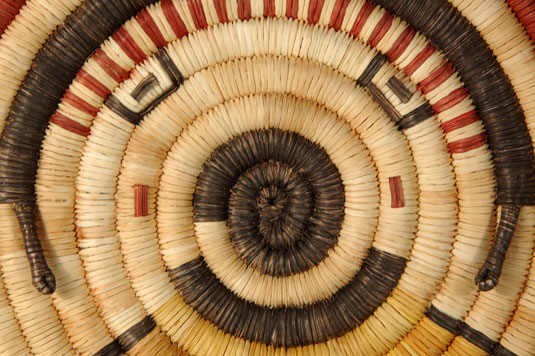Hopi Second Mesa Hahai-i-Wuhti Image Plaque [SOLD]
+ Add to my watchlist Forward to Friend
- Category: Trays and Plaques
- Origin: Hopi Pueblo, Hopituh Shi-nu-mu
- Medium: galleta grasses, yucca leaves, dyes
- Size: 10-1/2” diameter
- Item # C3856A SOLD
The Hopi Indians have a long tradition of existing in the harsh, dry climate of Arizona where they rely on nature to provide for their livelihood. They have a strong religious belief demonstrated with their annual Katsina dances and in less visual means. They have preserved their traditional ways for a thousand years when one would expect that today’s modern culture would have supplanted tradition.
One of the ways the Hopi have preserved traditions is through making baskets. Outsiders may view the baskets as curio items or decorative items, but to the Hopi women who make them, they have a very important function in their lives.
The plaque is an especially important item in preserving the women’s role in Hopi society. Plaques are presented to newborn babies, young mothers, men as a wedding gift, as paybacks for gifts or favors, and in kiva ceremonies. Those are their main purposes and making them to sell to tourists is a secondary purpose. Plaques may be hung from the sash of a Katsina or from the hair of a Long Hair Katsina. They are used in initiation ceremonies and as rewards in young men’s footraces. Most importantly, they are used in the women’s basket dance.
Second Mesa basketry is made in the same manner as a thousand years ago. All materials are derived from nature and, in most instances, from the general area of the villages. Dyes used are from plant materials and not commercial sources.
Many designs are used on baskets but favored designs are those depicting katsina imagery. This plaque features the Hahai-i-Wuhti Katsina, one of the more colorful of the katsinas. Her portrayal is that of a sprightly Hopi grandmother. She is considered to be the mother of all katsinas. It is her image that is given to the very young Hopi babies and captive eagles.
Her hair is usually in long braids hanging over each shoulder, a trait cleverly demonstrated in this plaque by making the braids extend from the coils. Notice that the hands are shown in imbricated form. There is also imbrication in black yucca across the top row of the plaque as well in the eyes of the katsina.
The maker of this plaque, Ella Kewanyoma, is not listed in the most recent book on Hopi basket weaving so I am assuming she is a past basket maker who is no longer active. She was an excellent basket maker and demonstrated her interest in perfection by using three-dimensional and imbricated weaving techniques.
Condition: excellent condition
Provenance: from the collection of a gentleman from Colorado
Recommended Reading: Hopi Basket Weaving: Artistry in Natural Fibers by Helga Teiwes

- Category: Trays and Plaques
- Origin: Hopi Pueblo, Hopituh Shi-nu-mu
- Medium: galleta grasses, yucca leaves, dyes
- Size: 10-1/2” diameter
- Item # C3856A SOLD



